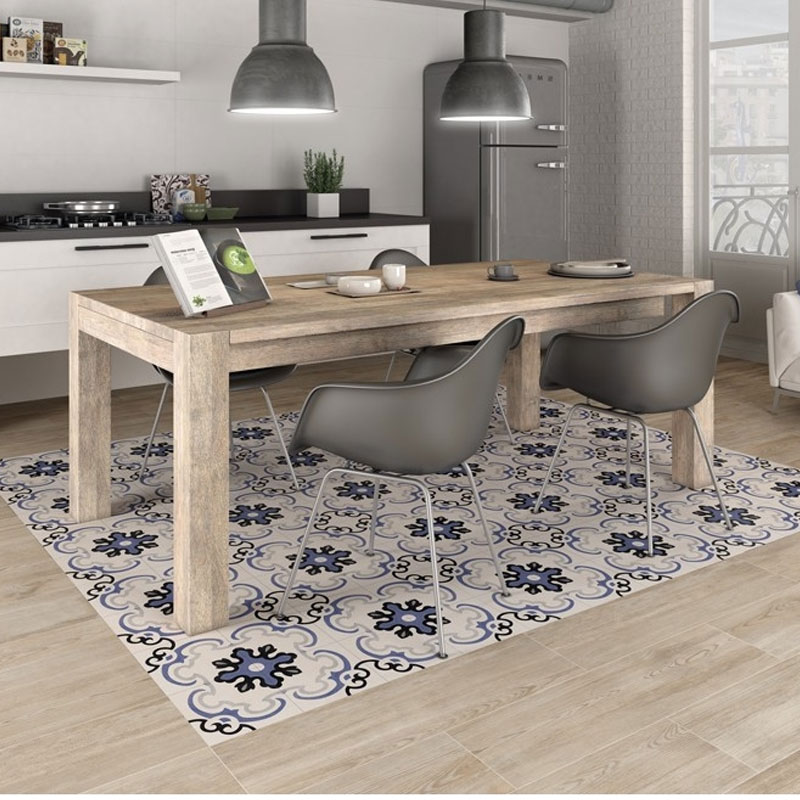Hydraulic tiles have become a trend in the world of interior design and decoration. In fact, they are considered as reference elements within retro and vintage styles. But what aspects should you take into account when choosing them? In ParaTuReforma we are going to show them to you.
What are hydraulic tiles?
First of all, we want to explain what elements characterize this type of tiles. First of all, you should know that their origin is really old, since they were invented in France in the mid-nineteenth century. Their success was such that they became the preferred choice of users until the 1960s. In fact, if you visit a house that has not undergone major renovations since that time, it is normal to find this type of tile on both the floor and walls.
Its name has to do with its elaboration process, given that to manufacture this type of pavement it was necessary to compact cement by means of hydraulic presses. Subsequently, a mosaic, geometric or similar pattern was printed by hand.

It is true that hydraulic tiles offered a very high level of resistance and durability. However, the emergence of new trends, changes in user tastes and the high cost of production were factors that put an end to their mass production.
However, retro and vintage styles have brought them back into fashion. Nowadays, porcelain stoneware is the material used to manufacture them. This compound is as hard and resistant as the pressed cement used at the time, but much more economical and with more design possibilities. You only have to take a look at our catalog of hydraulic pavements of imitation to realize it.
Main advantages of imitation hydraulic tiles over conventional tiles
The lower price and greater design options are not the only advantages that imitation hydraulic tiles offer over the originals. In addition, we can add that:
- They are much easier and faster to install and, in most cases, without the use of guides.
- They do not require any maintenance beyond frequent cleaning.
- They allow seamless installation, which is very useful in kitchens and bathrooms. bathrooms. Do not forget that moisture accumulates in them and they can develop mold and mildew.
- They allow the application of treatments that increase their adherence, which reduces the risk of accidents in the home.
- It is practically impossible to differentiate the imitation ones from the originals.
In addition, imitation hydraulic floors are now compatible with many modern air-conditioning technologies. We refer, for example, to underfloor heating. Original tiles, on the other hand, are not.
How to choose hydraulic tiles?
Having clarified the previous point, it is time to explain which aspects you should pay attention to when choosing hydraulic tiles.
1. Where are you going to put them?
Traditionally, this type of tiles have been placed on the floors of living rooms, bedrooms and other common areas of the home with the exception of kitchens and bathrooms. However, nowadays, you can also put them in these rooms without any problem.
However, the flooring hydraulic floors for bathrooms and y kitchens have some special characteristics. The most important are the absence of joints to prevent the accumulation of dirt and the application of treatments to give extra adhesion to the surface. Remember that these are the two places in the house where humidity is most concentrated and, therefore, where there is the greatest risk of slipping.

Similarly, this type of tiles can be placed on the walls of both rooms. In this sense, porcelain stoneware is one of the easiest materials to clean.
Size and format
The vast majority of imitation hydraulic tiles are square in shape. They are usually 20 x 20 cm or, at most, 30 x 30 cm. This is because, initially, the presses used for compacting the cement only allowed these dimensions.
However, nowadays, it is possible to opt for much more original options. This is the case, for example, of those with octagonal and hexagonal shapes. However, the thickness is usually invariable (between 17 and 20 millimeters).
3. The design
It is, without a doubt, the most personal question of all, since it depends on your tastes and the decorative style you have chosen for your home. However, the options are almost endless. Below, we are going to give you some examples of styles so you can see for yourself:
- Arabian. As the name suggests, it takes design patterns from Moroccan and Middle Eastern decor trends. Take a look at Harmony’s Casablanca collection to get an idea.
- Rustic. The hydraulic tiles of this style are reminiscent of old country houses. Within our catalog, we highlight Mainzu’s Rialto collection. It is possible to go a step further by adding a worn touch to the designs, as the Mudéjar De Keros collection does.
- Andalusian. Here we are talking about tiles marked by the use of whites, blues and similar tones accompanied by arches, mosaics and a bohemian touch. The Sevilla and Cartuja collections by Keros are clear examples.
- Retro. It evokes the predominant trends before the 1960s. Those of us who are a few years old remember them very well for the times we spent during our childhood at our grandparents’ house. Mainzu ‘s Nostalgy collection reflects its patterns very well through the use of pink and brown.
If you take into account these three aspects that we have just discussed, you can be sure that you will choose the best hydraulic tiles for your home. In this sense, if you have any questions or want to request a personalized quote, please contact us.


